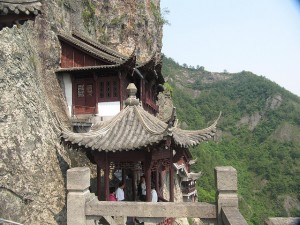 In late 1800s Japan, several Buddhist monks called Sokushinbutsu attempted the rare ritual of self-mummification. Driven by the Buddhist quest for enlightenment and the belief that this requires non-attachment from the physical body, these monks prepared to take their own lives while preserving their remains for history.
In late 1800s Japan, several Buddhist monks called Sokushinbutsu attempted the rare ritual of self-mummification. Driven by the Buddhist quest for enlightenment and the belief that this requires non-attachment from the physical body, these monks prepared to take their own lives while preserving their remains for history.
The practice was finally outlawed in Japan in the early 1900s, but not before several hundred monks and priests attempted the practice. Archaeological discoveries estimate that only 24–28 were able to achieve mummification and considered true Buddhas.
The process of self-mummification was long, complicated and tortuous. The goal was not simply suicide, but a full removal of oneself from attachment to the physical body and its needs and pains.
The full (not for the faint of heart) process went as follows:
Not unlike Egyptian mummification, the process had to painstakingly overcome physical barriers — and the monks, in effect, achieve incredible mental control. The first step was to remove all the fat from the body. They achieved this by adopting a diet of nothing but nuts and seeds for 1,000 days — nearly three years!
Next the monk had to remove all the moisture from his body. This stage lasted another 1,000 days, and reduced the already-meager diet to nothing but the bark and root of pine trees. After this time, the monk would drink a poisonous tea made the sap of the East Asian urushi tree. This toxic sap contains the same allergenic compound that makes poison ivy every camper’s nemesis.
The tea served two functions: It sped up the process of removing fluids from the body by causing vomiting; and it lined the inside of the body with its poison, defending against maggots.
The final step was to lock himself in a stone tomb, assume the lotus position, and wait. In the tomb, the monk had an air tube and a bell, which he rang once every day to let those outside know he was still alive. When the ringing ceased, the other monks would remove the air tube and seal the tomb. After a final period of 1,000 days, they would re-open the tomb to find out if the monk had achieved mummification. In most cases, they had not, but even “unsuccessful” Sokushinbutsu were revered for their awe-inspiring sacrifices and resolve. The estimated two dozen who were mummified were viewed as true Buddhas.
“If a man can control his mind, he can find the way to enlightenment.” – Buddha
Although the self-mummification process sounds unbelievable and even gruesome to most of us, you cannot ignore the awe-inspiring peace of mind a man had to achieve to endure the 6+ years of slow and deliberate death in the name of enlightenment.
Learn about more traditional Buddhist funeral rites from SevenPonds.

 Bizarre Death Ritual: 19th Century Buddhist Self-Mummification
Bizarre Death Ritual: 19th Century Buddhist Self-Mummification


 “Help Me, Helen”
“Help Me, Helen”
 Recovering Cremation Remains After the Los Angeles Fires
Recovering Cremation Remains After the Los Angeles Fires
 “As Tears Go By” by Marianne Faithfull
“As Tears Go By” by Marianne Faithfull














